MARTIALFORCE.COM
PRESENTS
MARTIAL ARTS AT ITS BEST
SOKE HAISAN KALEAK
AUG / 2009
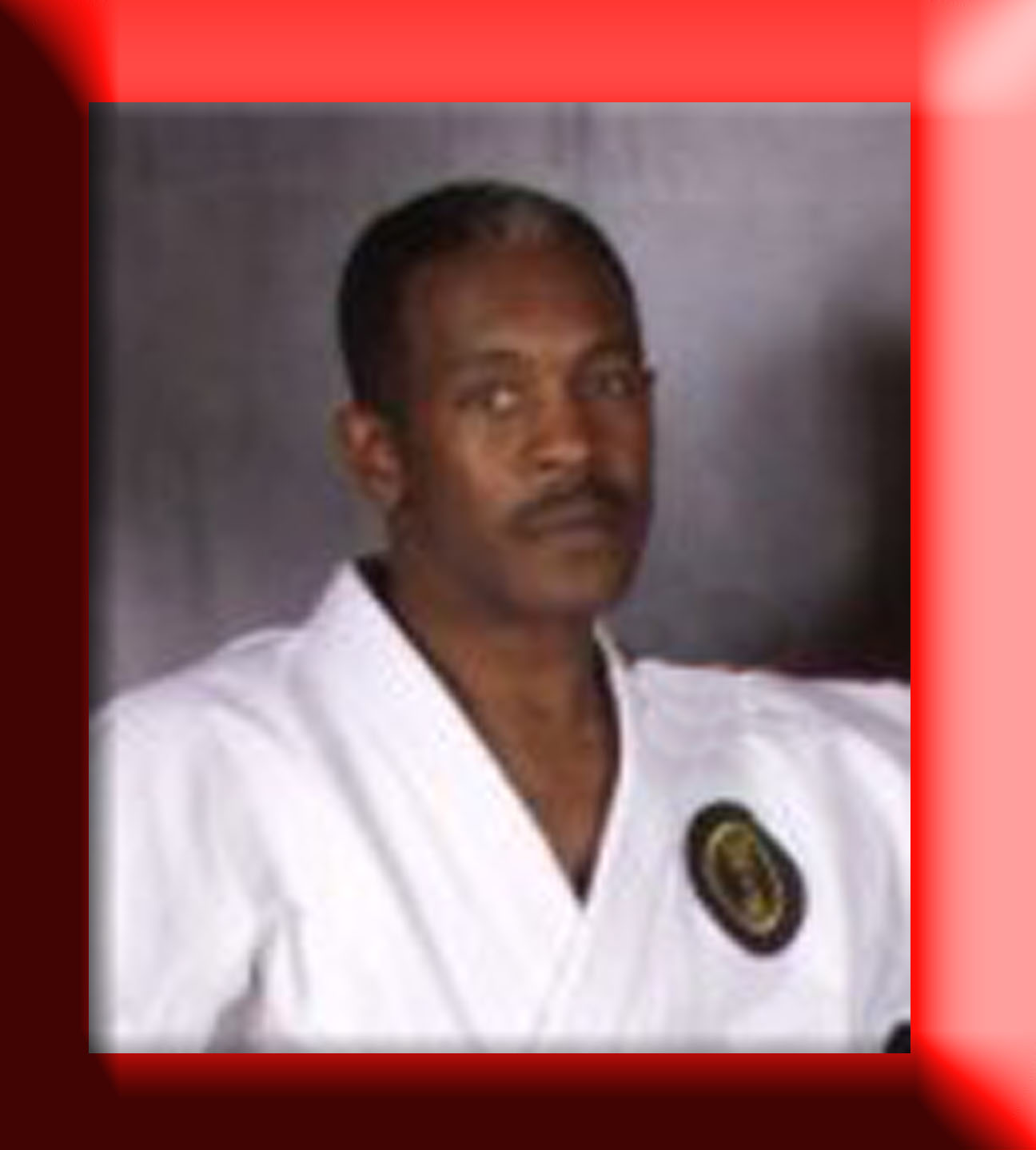
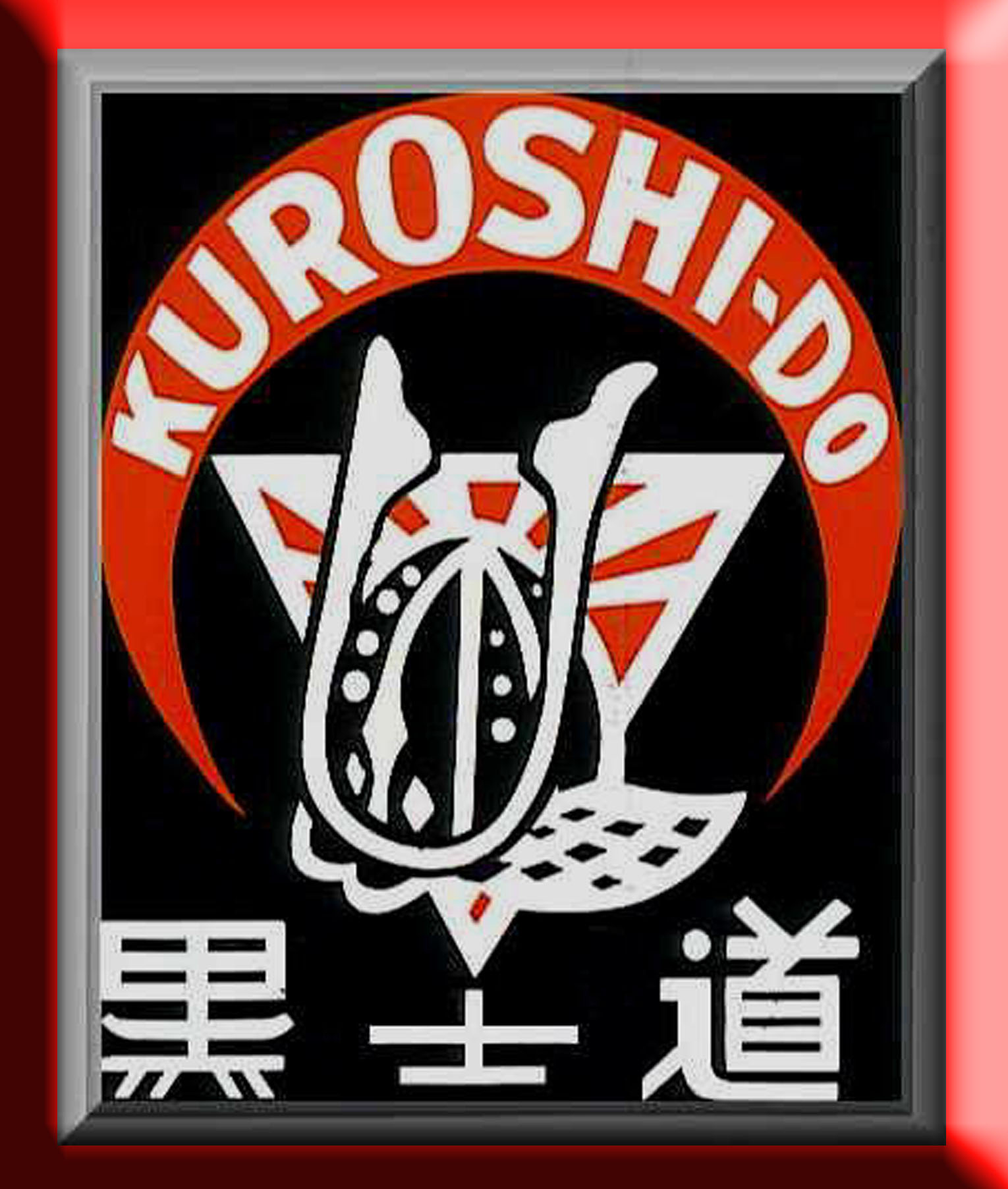
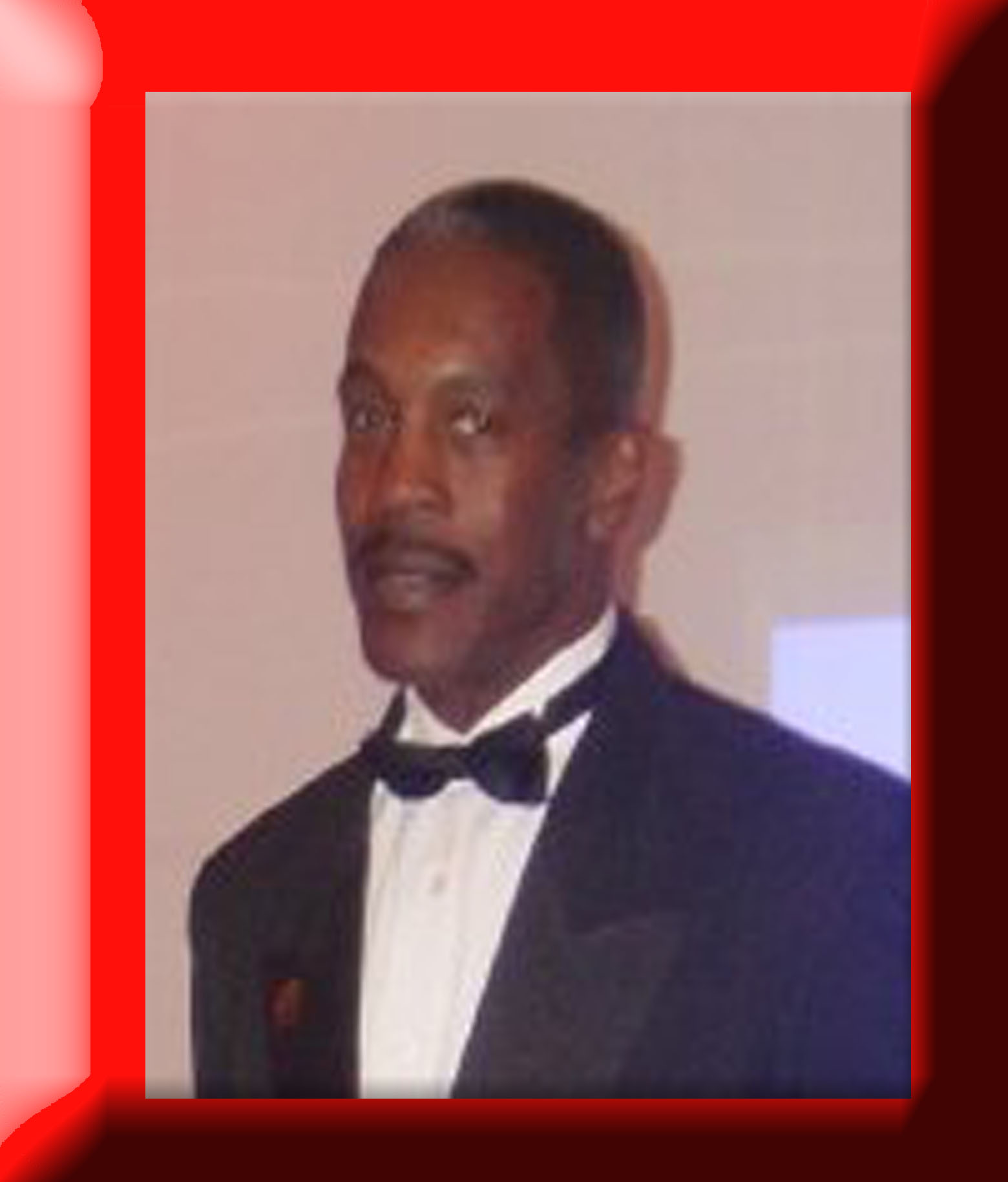
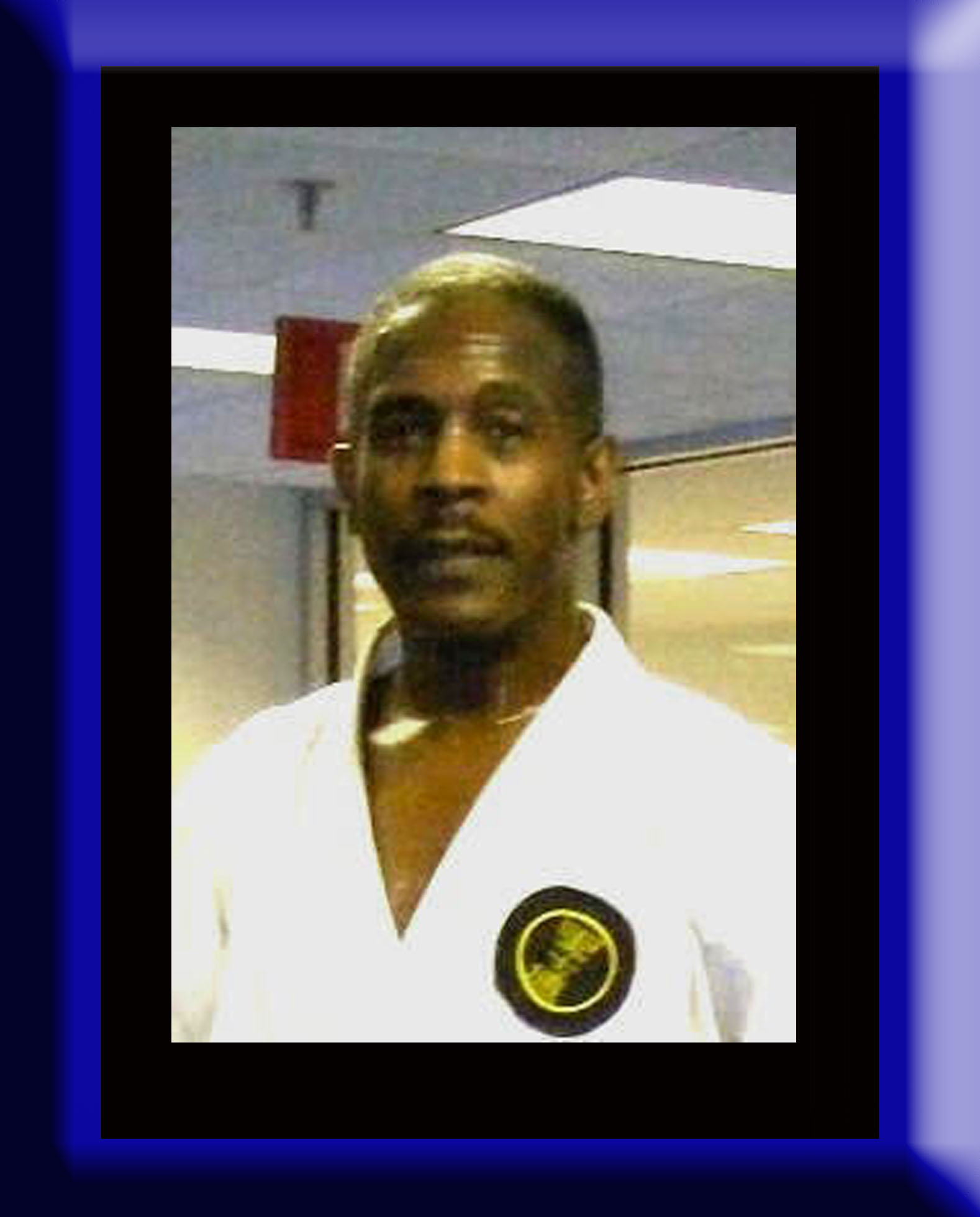
Co-Founder oF Kuroshi-Do
Interview by William Rivera Shihan
Written by Lydia Alicea
Martialforce.com Online Magazine
It was your typical summer afternoon in New York, slightly muggy, but with sunny skies. This was a “beautiful” day that would set the stage for what we came to the Brooklyn Sports Club to view and take in. Shihan and I sat and watched as Haisan Kaleak Soke conducted his class through the repetitive drills of their instruction. “Drill Master” as he is often referred to by his students, was moving them into the zone.
On the floor were several young men watching intently with eyes wide open. We later learned that they were about to make an important commitment to come on board. Soke, tall and lean, with graceful almost as if dancing movements, quickly shifted into lightning quick thrusts of energy, demonstrating “bunkai” through repetitive drills that proceeded with precision that snapped.
It is indeed magical to see the application of bunkai in a traditional yet “untraditional” manner. By that, I mean with an instructor who teaches with logic and practicality along each step. I learned that the cornerstone of Kaleak Soke’s instruction, parts, separate and then together, are rudiments to him today as they were as a young boy, a real “Brooklyn Boy.”
As a kid growing up in Central Brooklyn neighborhoods during the 1960s, Haisan was able to nurture those innate abilities into talent through gifted instructors and artists who taught him. I mentioned it was a beautiful day. Indeed, it is “beautiful” to see what happens when talent can affect the outcome of people’s lives when it is applied in a positive manner.
Through speaking firsthand with his students, (one shared with me that Soke lives inside his mind’) with parents and observing the ‘intent’ through the eyes of his young students at the Brooklyn schools where he teaches, it is beautiful when efforts can move others in a positive direction that will enhance their lives.
Martialforce: Share with us, where you were born, and where did you grow up?
H.Kaleak: “I was born in Brooklyn, New York. I grew up in the Bedford Stuyvesant, Brownsville and East New York sections of Central Brooklyn.”
Martialforce: When did you have your first contact with the martial arts? Who was the instructor?
H.Kaleak: “My first contact was at the age of approximately nine. I began my formal training a few years later. My very first teacher was Kaicho T. Nakamura, Kyokushinkai. My story began as a young child, one of those kids running around the streets. A group of us local kids would go to the local Karate school at the Brooklyn Academy of Music in downtown Brooklyn.
It was a very small space due to the ceiling that if you walked to one side of the room, it would slant. He would invite people up to the class to watch or practice. Kyokushinkai was a very hard style. The class would do kiba-dachi punches and we would run in and out to catch a glimpse, or curiously sit down in the back of the room to watch. One day, while running in and out , the instructor grabbed me by the collar and proceeded to give me my first lesson.”
Martialforce: What interested you about the Martial Arts, did you always want to learn?
H.Kaleak: “Actually, I did not but I did have a passion for building zip guns. My mother did not approve and told me, "You have to get out of this." She did notice my enthusiasm from that very first Karate lesson. I could not stop talking about it. She was encouraged by this.
I later realized that my interest in guns was not about building them, but more about taking them apart and putting the parts back together. I later applied this aspect to my martial arts training; broke down what I was learning into ‘parts’ taking the best of this, putting it together with that and making its application practical.”
Martialforce: Tell us about your instruction with Nakamura.
H.Kaleak: “Nakamura is a first generation instructor of Kyokushinkai-Kan. In retrospect, I am fortunate even for the short period of time that our paths crossed, especially at such a young age. Although I never got an acknowledgement from him that he had taken me under his wing, I never took offense. It was not until I trained under other instructors that I experienced that "take me under your wing" feeling. To this day I appreciate his teachings. Shortly after that I began studying Shotokan Karate.
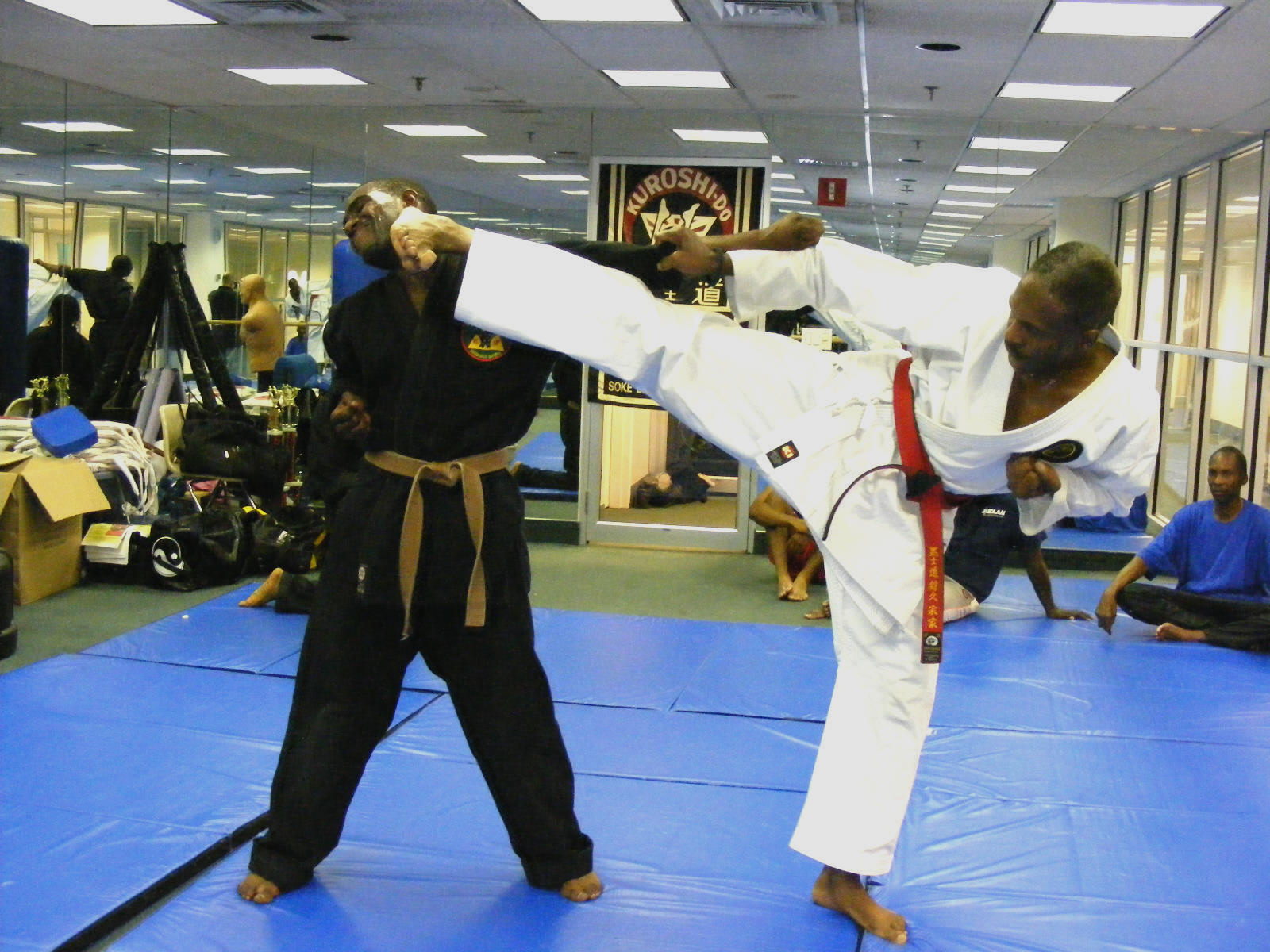
Martialforce: That was with Steve Alston Soke.
H.Kaleak: “Yes, he was my first teacher in Shotokan Karate. He later became one of the co-founders of our system Kuroshi-Do. As I recall, he was already a black belt when I became one of his students. We were friends, he was slightly older than I was and we did not train together all the time, until we found a place to practice. We never looked at rank, but he was ahead of me and I was his number one. Until today our friendship remains strong.”
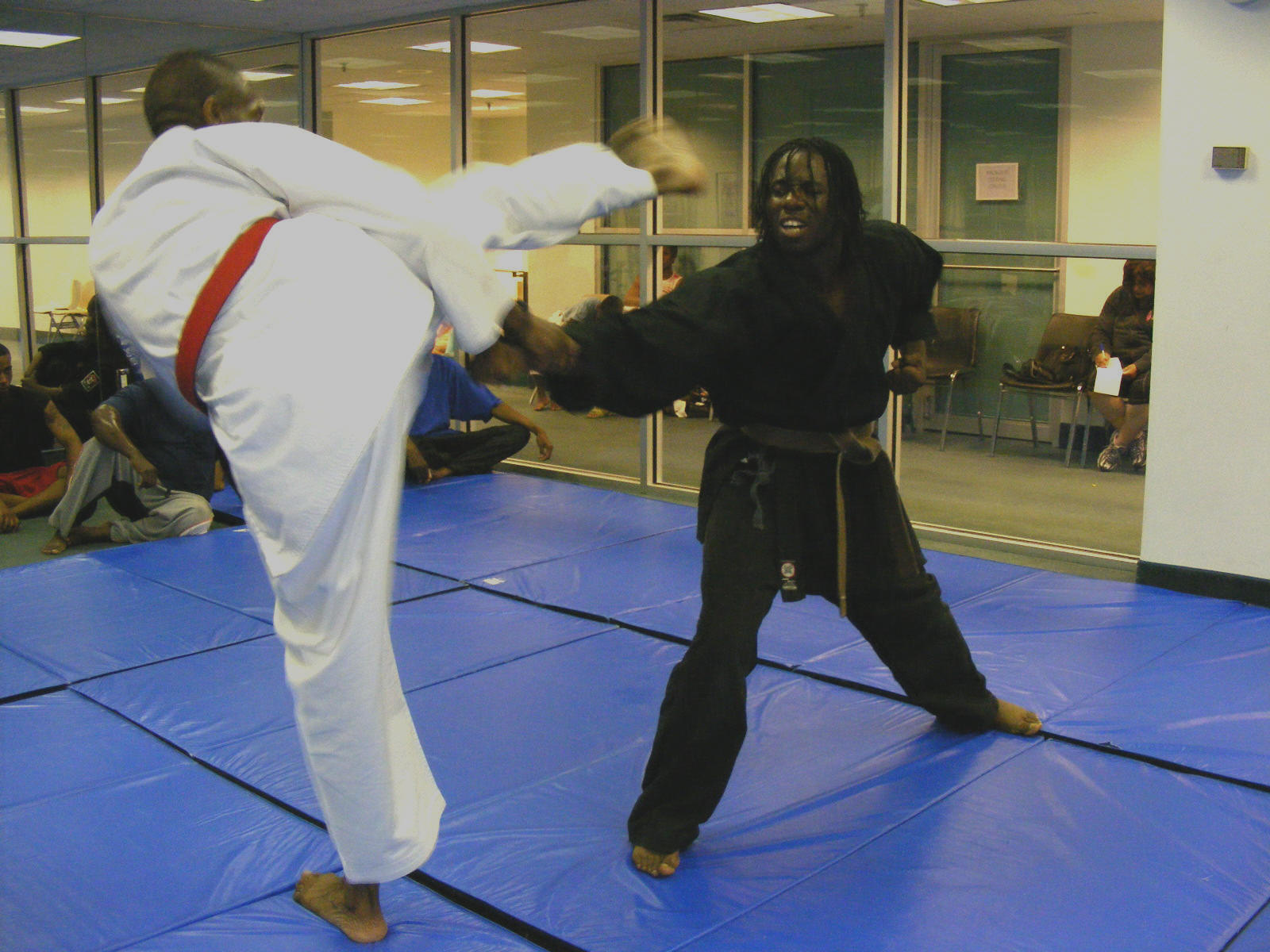
Martialforce: Which instructor(s) influenced you the most?
H.Kaleak: “Certainly, my greatest influences came from Supreme Grandmaster Dr. Moses Powell, Grandmaster Mas Oyama and Steve Alston Soke.” I trained with Dr. Powell and Soke Alston. Mas Oyama was more of an inspiration because of what he had accomplished at that time but I never trained with him.
Martialforce: Which martial arts have you studied?
H.Kaleak: “I have studied Kyokushinkai- Kan, Shotokan Karate-Do, Aiki Jiu-jitsu, Kobudo and Judo.”
Martialforce: Please tell us a little bit about each of your instructors.
H.Kaleak: “Kaicho T. Nakamura: He was a hardcore basics trainer. His motto: "Sweat to avoid bleeding" his influence was strong because I learned how a strong physical workout can create an equally strong mental posture. Basics was the key! It was an honor to have trained with him, first generation Kyokushinkai-Kan.
Steve Lusayne Alston: Again, Steve was one of my early instructors in Shotokan Karate. He was a student of Grand Master George Cofield of American Shotokan. When I met Steve Alston, he was a student of Eric James; a senior student in Kyokushinkai-Kan. Alston encouraged me to become a kumite fighter. He had superb weaponry skills and all around ability to blend styles. He later founded the Kwanduks Dojo where I became a senior student.
Thomas LaPuppet: Master LaPuppet was a Shotokan Karate Trainer. He was the first Black Martial Artist to bring Karate to the AAU Games. LaPuppet was also a member of the New York City Fire Department. His fire station was located across the street from Kwanduks Dojo. He became a mentor to our school. Although I only trained with him for about four to five years, I gained tremendous knowledge from his teachings including the utmost importance on executing kata. My introduction to the Tong Dojo was through my association with Master LaPuppet who was senior of those ranks.
George Cofield: He was a Shotokan Master and LaPuppet’s teacher, a fighter! He stressed Kumite (fighting). In order to gain entry into the dojo you had to fight.
I will forever remember his introduction of what the members of Tong Dojo referred to as “The Circle of Death.” The name spoke for itself. His favorite technique was the reverse punch. His motto: One Punch One Kill.
Ronald Duncan: His style is, The Way of the Winds. I trained with him, no rank just trained. Weapons were one of Master Duncan’s strengths. I learned from him that weapons are an extension of one’s body, and the art of stealth. To this day, he remains an admirable instructor.
Professor Florendo M. Visitacion/Professor Vee: He is best known for the art of Vee Arnis Jitsu. He was a humble scholar, a philosopher, a giver of principles. His style was to observe closely and then teach. I learned at my own pace. I never heard a harsh word from him. He spoke softly with intense perseverance. I learned valuable lessons in pressure points from him. He always made me feel like family. His principles are still with me to this day.
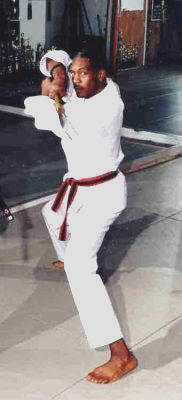
Supreme Grand Master Dr. Moses Powell: His style was Sanuces-Ryu Ju Jitsu. I met and trained with him in the Brownsville section of Brooklyn. When Grand Master Powell sanctioned the Kuroshi system, he gave it legitimacy. He taught me the intricacies of putting the martial arts together, to allow it to flow and to pay close attention to the dynamics of the body. He showed me what the human body can and cannot do. Grand Master Powell was my last official instructor and without a doubt, the greatest teacher, who gave me tremendous knowledge that influenced my abilities.
He would often say, ‘You cannot take a man and teach him to be hard and ridged when he must flow like a stream.’

“Little” John Davis: Davis Soke was a student of Grand Master Powell who trained with him in Harlem. From Soke Davis I gained greater insight of Dr. Powell’s teachings. I learned a great deal from Soke’s fighting abilities and self-defense tactics. It is an honor to serve with him.”
Martialforce: Discuss the idea behind Kuroshi-Do. Who was involved in its creation?
H.Kaleak: “As Steve Alston Soke and I diligently studied the martial arts, we learned through our tours in the military the role of the Special Forces as a necessary component in combat. That impressed us. The Navy Seals and the Green Berets are examples of the best elements of the U.S. Military. Borrowing from the idea, ‘Representative of the Best,’ Kuroshi represented an elite team of trained martial artists, belonging to the very best in the martial arts world. Members of the Kuroshi squad studied Shotokan-Karate Do, Kyokushinkai-Kan, Judo and Moo Duk Kwan. We became the backbone of our system and some of its original members are still with Kuroshi-Do today.

I became Chief Instructor for all members of Alston's Soke Kwanduks Dojo. Master Alston was the sole founder of Kwanduks Dojo; it was during this period that the idea of Kuroshi began to take form. From the dojo, we had six to eight students who wanted to train even harder. We would run in Prospect Park three times a week before we went to school. We trained all night on Saturdays, sleep little only to compete on Sunday in a tournament. This was a process that many competitors were using at the time and we wanted to stay on top of the competition.

The Kwanduks Dojo became well known and was able to expand membership throughout various New York and New Jersey communities. My role within the Kwanduks Dojo was to instruct the new students.
All its members worked hard to foster the reputation of the system wherever they went. Kuroshi-Do originally had five founding members: Steve Alston, Haisan Kaleak, Salim Al Rashid, Kenneth Cooper and S. Papasan Canty.
On a recommendation from one of our members, we expanded the name of the system to Kuroshi-Do, which translates into The Way of the Black Warrior.
The Kuroshi-Do system is comprised of five styles: 1. Aiki Jiu-jitsu, 2. Shotokan Karate Do, 3. Kyokushinkai-Kan, 4. Moo Duk Kwan, and 5. Judo. Kuroshi-Do has demonstrated itself to be a style that is practical and proven effective in self-defense and in tournaments.
We did not have separate classes for women, or for children, everyone practiced together. We never put two women together because males commit the majority of attacks on women. This can be tough for some of our students, but reality dictates the need to teach in a practical manner. We want our students not to get shocked if they are grabbed or attacked on the street.”
Martialforce: Did Kuroshi-Do, The Way of the Black Warrior, present a problem?
H.Kaleak: “Some Caucasians may ask if Kuroshi-Do The Way of the Black Warrior is not an art exclusively for blacks, then why define it that way.



Haisan Kaleak with two of his top students Emmanuel "Ki-yuki" Ackers on the left and Jason "Bukai" Banks to the right.

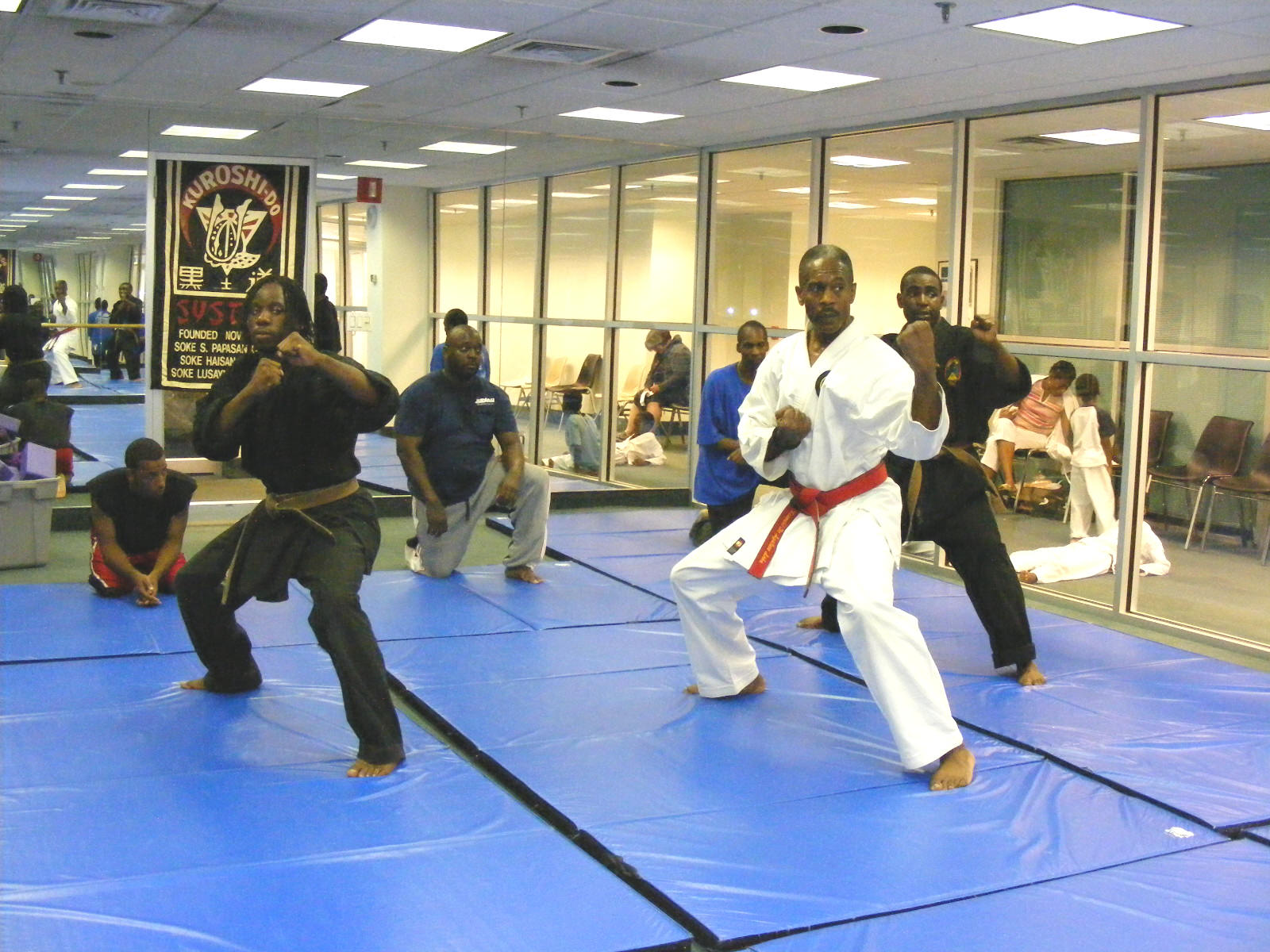
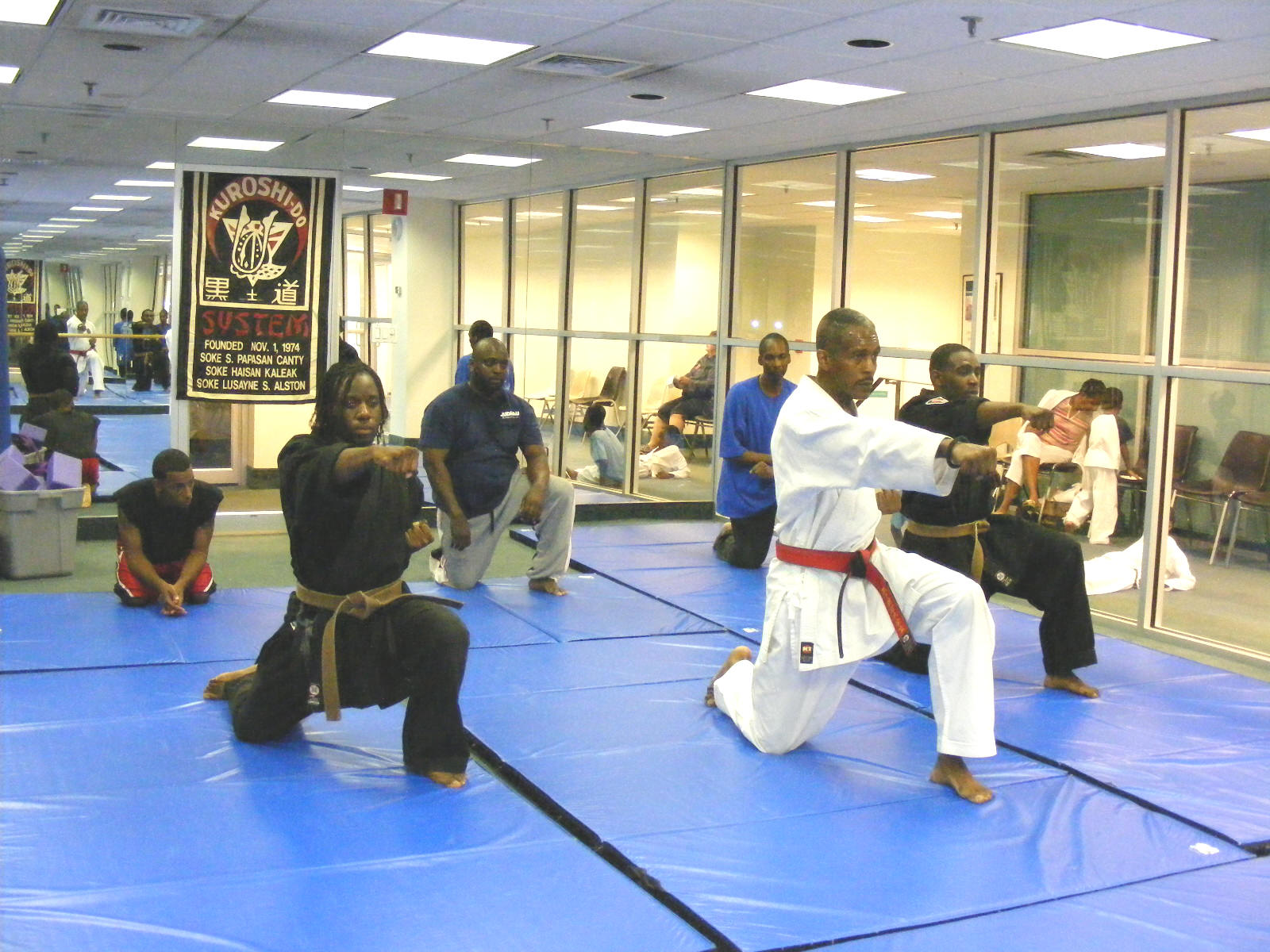
My response is simply this: to its founding members, it represented a system created by black individuals that had everything to do with self-pride. We have integrated certain aspects of African culture into our teachings for a reason; we are teaching a martial art to individuals in predominantly black neighborhoods.
It is important to point out that Kuroshi-Do has its roots in the Japanese martial arts; we use their customs and their words, without changing its meanings. We believe a student should be able to pick up a Japanese book and know what the stances and words mean. I use the Japanese language for concentration when teaching techniques.”
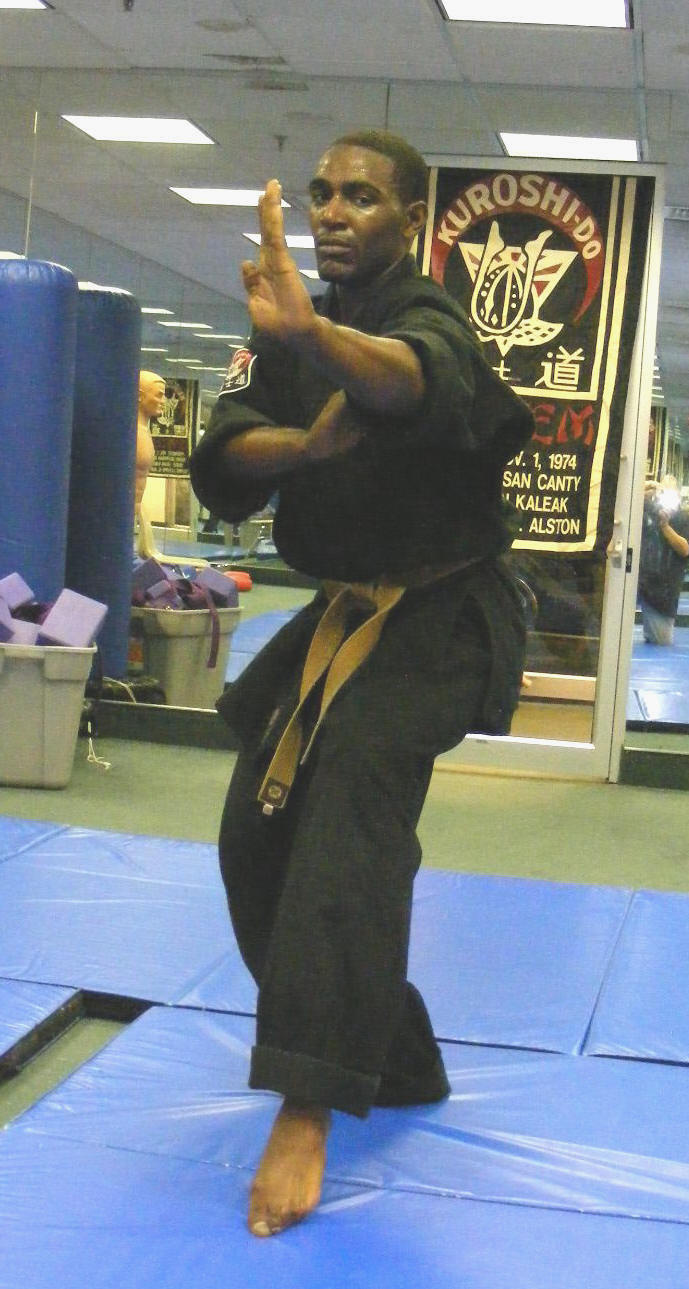
Jason "Bukai" Banks
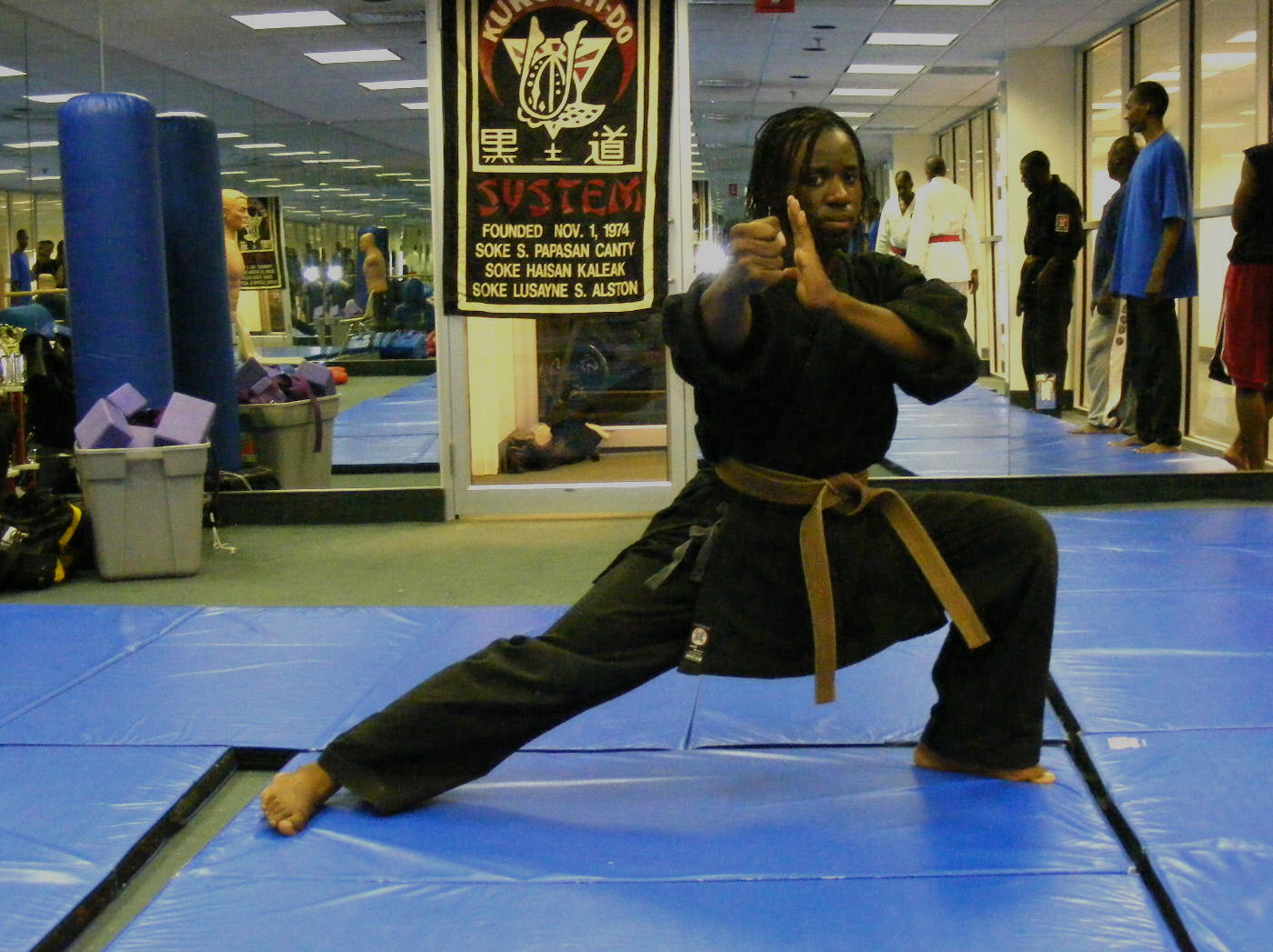
Emmanuel "Kiyoki" Dickens
Martialforce: Describe the kata in your system.
H.Kaleak: There are approximately eleven to twelve kata, from white belt to black belt. We use the colors White, Yellow, Green, Purple, Brown, and Black. Each rank has two kata forms and kobudo is required from purple belt and up.”
“Our kata were created with aspects from different styles. In the beginning, all our black belt forms were from Shotokan Karate, meaning that once you got to first degree you had learn all their forms. We are confident that our system prepares one to compete against anybody’s game and beat him or her at it.
If my brown belt goes into a Kyokushinkai school, he should be able to hang with them. He will not be too fast or over his head, he is going to be able to improvise, adapt, and overcome. The slogan we use is I.A.O., ( Improvise, Adapt and Overcome ).
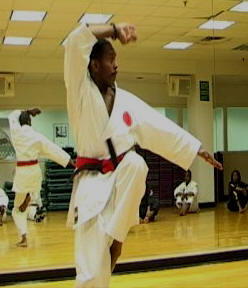
In Kuroshi-Do, there are areas where you can excel so if one chooses to concentrate on the Judo and Ju-jitsu aspects; it is ok because you will still learn the style. The system adjusts to the student instead of the student adjusting to the system.”
Martialforce: Does Kuroshi-Do include grappling, restraining, and throwing techniques?
H.Kaleak: “Yes, it includes all of these.”
Martialforce: At what level do you teach students bunkai?
H.Kaleak: “Bunkai is taught at the very beginning of a student’s training.”
Martialforce: Does Kuroshi-Do include weapons training (kobudo)?
H.Kaleak: “Yes, the system includes weapons training.
Martialforce: Do you feel all students should train with weapons?
H.Kaleak: “Only students committed to the reflex training required in handling weapons should attempt this. I only encourage students who have the will and the desire to train in weaponry.”
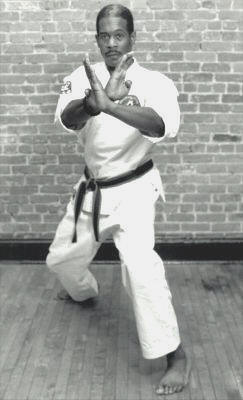
Martialforce: What differences do you see in the martial arts tournament competition today when compared to when you competed? Do you feel the differences if any, will have a positive or negative affect on the future of the martial arts?
H.Kaleak: “When I think about my participation in martial arts tournaments over the years, and see what is going on today, I see significant differences. During my days of competitions in New York, many were at places such as Sunnyside Gardens, Queens, or at the Manhattan Center or Madison Square Garden in Manhattan. They were seen as the famous gladiator arenas for martial arts tournaments.
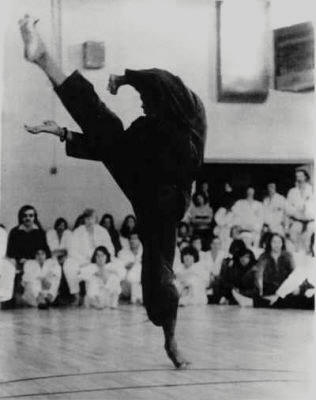
Within these arenas, competitors represented their styles with honor. They participated to represent the style not themselves. It was more about respect and the privilege to compare your style to the style of other warriors while showing appreciation for both. Today, unfortunately it seems we have lost the ability to pay honor to the arts we represent and to our teachers. It is sorely missing. Surely, if the lack of respect is not reversed through the practices of the arts, then it will erode them creating an adverse affect on its future.”
Martialforce: Our research shows that you also train law enforcement and security personnel. Is the training for officers different from regular training and if so can you explain why?
H.Kaleak: “Through my experience I have seen that most law enforcement and security personnel trainees are not interested in a commitment to the arts. Their focus is to learn straightforward self-defense. I like to call it personal defense. They want to learn how to protect themselves with little interest in the development of the mind, body and spirit as most martial artists strives to achieve.”
Martialforce: You have said that Grand Master Powell helped put your martial arts together. Explain.
H.Kaleak: “A motto of his was, ‘Take this and put it with what you have to make it better.’ I never heard him say to stop doing something I had learned previously, or that this is wrong and this is better. He had the ability to touch so many people while watching them develop into their own. His teachings created permanent impressions. Until this day, I tell my students, ‘My job is to make you better than me, the problem is, I am getting better every day.’
I try to make Kuroshi-Do simple and effective, directly to the point, touch and go. Your technique should be like that as well. While teaching pressure points and nerve strikes, I emphasize knowing where to hit. You need to know how to knock a person out and wake him up with the same strike, know the timing of when and how to hit, how to respond with intent to stop an attack and bring a person to a moment of understanding that it was a mistake.
When we choose to study a style, we are agreeing to take on its characteristics. While developing Kuroshi-Do we applied what we learned years ago, keeping in mind that if, you are not going to practice an art in its purest form out of respect you should call it something else. It is not egotistical to say that we do not need a particular aspect, or to change how you practice, but it is no longer true Shotokan. Powell taught us to always ‘Remember where you came from, never forget to teach the history.’”
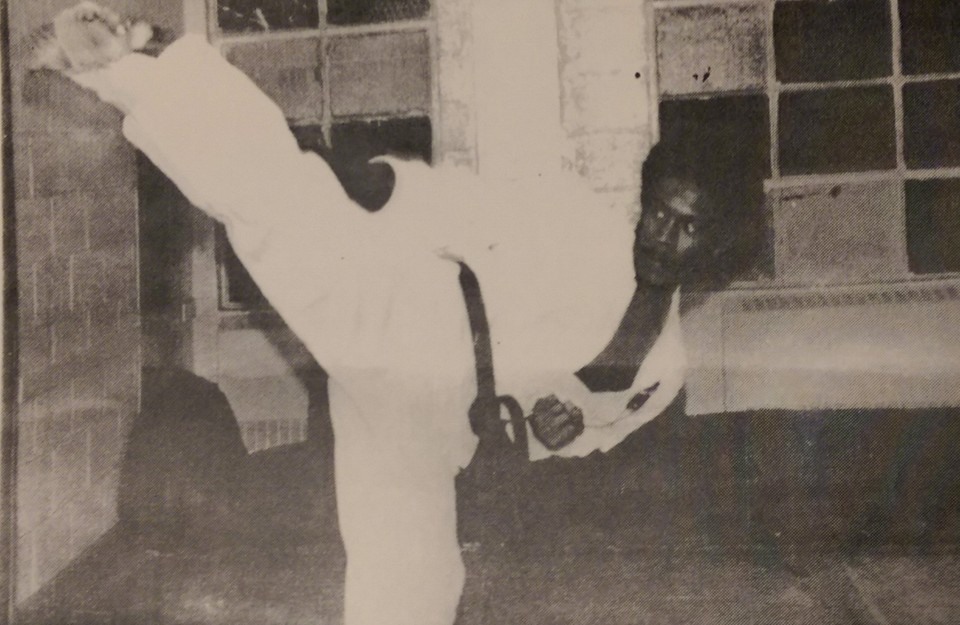
Martialforce: Did you train in the military?
H.Kaleak: “Yes I did when I had a chance to go to Okinawa. What was evident about training overseas is that it all comes down to proving yourself. When you can demonstrate your abilities, it is only then that others may accept you.
Many people forget that Mas Oyama was Korean and was head of one of the largest Japanese systems, Kyokushinkai-Kan. There is a form of acceptance in the martial arts where if you prove your worth, gender or race can be overlooked. You certainly see it although not as prominently.”
Martialforce: How do you teach the art?
H.Kaleak: “When I begin with new students, I first find out what their perception of the martial arts is, usually it is sport. It is true that the “sport” aspect of karate is appealing to many. Yet, often overlooked is emphasis on form, technique or application. An individual can do a perfect kick, but given an opportunity to apply its impact against an assault on the street, you have to know how to use it in self-defense. It is important and responsible to teach young students when they see the flamboyant kicks that it is only a partial aspect of the martial arts.
There is reality and then there is what we think is reality. My focus is to teach an understanding of concepts right from the beginning. However, it can be challenging to reach children. Kids are all over the place, but if you have enthusiasm to connect with them, you find the right modality.
When I work with the young students, like here at P.S. /I.S. 323 in Brownsville, Brooklyn, I have my brown belts assisting, which are also learning as well. They are part of our mentorship program to become “teachers.” As I lead the youngsters through instruction, my brown belts are on the floor, showing them as I do while making those important connections with the kids.
One of the teaching methods I use is to have the students count each step such as in a kata. When we use counting, they are associating a body movement to a number in succession; I listen to their counting, watch their steps, and see if they are connecting.
You know we have senses, the kinesthetic, the audio and the visual. Some people can learn using the sense of audio. Example, I can call you on the phone and say Lydia, you are going to learn a kata. As I describe to you each step, you hear and visualize. You can learn well this way, or like many people, you need to see it visually, see it executed. As a teacher, I need to know what works best.
If you watch a class, it may appear as if they are all learning the same way, but in reality, all are learning differently. If an instructor speaks loudly, some will focus on the audio aspect and be precise about what he is doing, breaking it down. I allow them to use the method that works; once I have everyone doing it in cadence, I get a better observation. I do not allow the kids to be lulled into, ‘When I get this step I can later be able to do the rest’. The idea is to teach the moves in sequence and once you teach the sequence the technique will come forth.
Some people try to build the technique by building one thing on top of another. What is important is to keep it kinetic, moving and structure will follow. If it does not work, you have taught from the top down. You must identify what the student is not getting, is it the stance, the block, the concept of hand to eye contact?
I use analogies for what I want them to do. Example, when you play with a play-station, do you look at the controls and then at the screen? No, of course you are looking at the screen. Well, it is the same thing instead of looking at your hand you need to look straight ahead.”
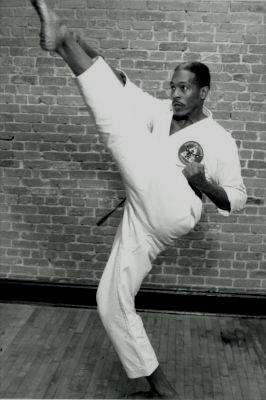
Martialforce: Discuss the repetitive drills.
H.Kaleak: “One of the nicknames people have given me is The Drill Master, and they say, ‘Oh no, here he comes with another drill.’ Repetition enhances muscle memory. Muscle memory allows them to get the movement and embody the technique. When a student begins to feel what he is doing then I can name it. When the student can remember the name and where it is at in the form, it is repeated and repeated. He no longer has to think about it because he can instinctively apply it.
You get people who think that you cannot execute a front stance with hands in a double shuto position or that in a cat stance you cannot do an upper block. Without the breakdown, they end up associating the stance with the move. Unfortunately, they are moving up in rank without learning to take apart the pieces and put them back together for its practicality. When we use the drills, their learning curve moves quicker, they are getting the concepts and seeing the feedback.
Take what I call Stop Drill. If you need to stop someone, you should not have to repeat your action ten times, but with a variety in your arsenal, you have more confidence in the stop. You may not use them all, but they are options. They become the drill that I mix up like a Bunkai.”
Martialforce: Talk about one concept you teach.
H.Kaleak: “One of the hardest things to get across to students, and one concept I teach is that the safest place to be in a conflict is where the opponent is standing. It is somewhat like the eye of the storm; it is always quiet in the middle as the storm rages around. A person cannot set if you are in their space. If you are in their space, you can control their breathing and make the heart beat rapidly. This is human physiology, the natural reaction of a person, and I want to control it. If I can predict his next move, I can re-direct it, and anything I do inside that circle is going to work.
The concept in W.A.V.E. "Woman Against Violent Environment" that I emphasize is a lot of handling. I put students in between, pushing them back and forth. Example, when someone is pushing you, what I want you to do is lower your center of gravity. It will make you more stable.
It is more effective than teaching stance because in stance, you must have the 70-30, 90-10, 60-40, you must have the equation to make a stance balanced whether it is a back stance, cat stance, or front stance.
All too often, in combat, you make actions happen, but you do not understand the why. I spend a good 45 minutes teaching foundation, similar to in Aikido; they are not teaching stance, they are teaching foundation. Understand, as I am teaching motion or stance, I am teaching Shotokan; the snap of the hips, all those things must be interpreted for the layperson to understand in order to go back and see what the style looks like. We can see it from where we are sitting without actually doing the moves, and no matter how fast it is being done we can still notice the style.”
Martialforce: For you, is technique more important than style?
H.Kaleak: “Oh definitely, I do not want to influence a students choice of style. Let us say one moves to Florida. A student approaches a school he is considering, and says, ‘Excuse me, I studied Shotokan. Can I train here?’ Response, ‘Well, we practice Tae Kwon Do here.’ It should not matter. If you are talking about stance or blocking, or foundation, what I teach should enable a student to practice in any style.
There are only two kinds of ways to defend: Interception and Evasion, there is no martial art on the planet that uses a third. Either you move out of the way or you put something in the way. Now interception, that is your style at work, but if you are moving out of the way, you are utilizing concept. If you can intercept and move at the same time regardless of style, your technique will click.”
Martialforce: Discuss aspects of the W.A.V.E. and the T.N.T. programs.
H.Kaleak: “W.A.V.E. (Woman Against Violent Environment) is a self-defense program created for women designed to teach them how to deal with their environment, where they live and work. During a 2-hour seminar, I spend better than an hour working on what I call the mindset; how it is counterproductive to walk around being paranoid when what is effective is understand your environment.
We deal with the emotional state, from the position of the victim and the attacker, and intention. On both sides, there is always an emotional and intentional state, just as there is also method of attack and defense. The anatomy of attack is composed of all these parts: the attack, emotional, intent and method. I use visual aids to get the class emotional, to get their mindset right, to the point that they will not allow themselves to become a victim. We include a film presentation of my students demonstrating techniques. I teach students to deal with ultimate aggression by putting a smaller person against a bigger person, stronger against weaker.
In Tactical Neutralization Training, or T.N.T., I emphasize that the use of tactic makes any technique effective. It is the way to apply technique. I support what my teacher Moses Powell taught me about neutralizing a person; it takes very little. There is an expression, chance favors the prepared mind: since the potential for something to happen on the street is unknown. If you have trained, you are in a better position to handle a situation.
The tactical advantage is how you apply a technique, making it real in the way you practice. Sometimes people forget to take kata and put bunkai to it. They forget to take the bunkai and make it live. There are steps, kata, bunkai, ippons, and then kumite. Sometimes you forget them, leave the technique in the kata form and make a person think that is self-defense when it is not.
It has to elevate to the next level and come around. From kumite, you have to get back to the kata because once you reach the ultimate goal, which is free fighting you are then moving around kata. What is tangible about tactics? It is the principle, the common denominator. If we were talking about stance, the common denominator is to lower your center of gravity. I tell students that no matter what the stance is you have to lower your center of gravity. What happens when you throw a cat into the air? He automatically flips over. Understand principle. Without lowering you center of gravity, you have to wait for gravity to let go. If you lower your center of gravity, you are automatically in a stance position. If pushed, you can fight from there, but when you lock your heels to the ground, you have to wait for gravity to let you go before you can react.
What I do in a drill is to push and pull them. The more you lower your center of gravity the harder it is for that person to pick you up or throw you. You are interrupting the movement and that gives you the window of opportunity. When that happens and a few seconds is not a long time, it should be long enough for you to do this and that. If it is not, that is where the training comes in. What I do is make sure a student can see the improvement they have made by assessing their reactions from when they first come in.
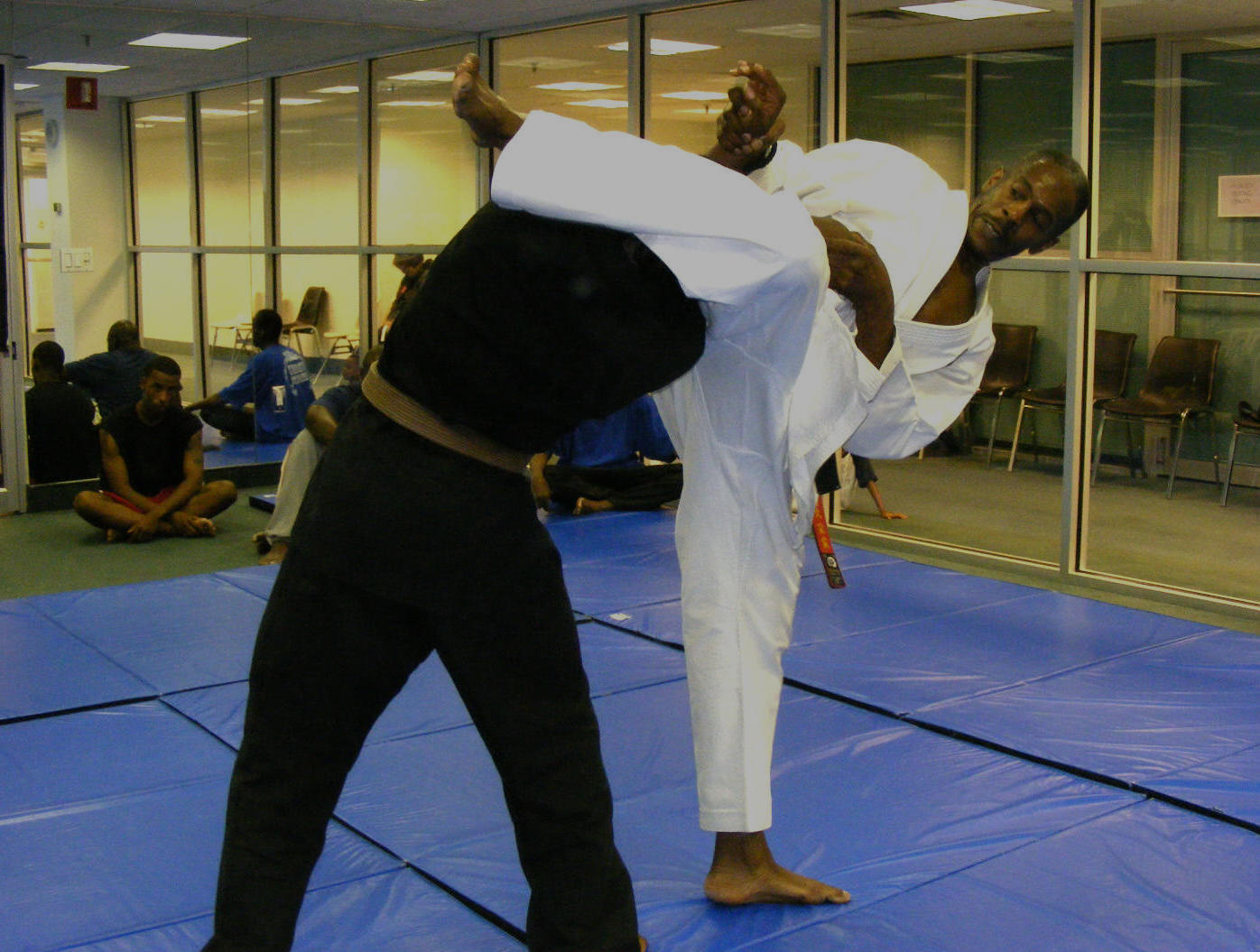
Martialforce: This may sound like a cliché question, but the answer always varies because of experience and insight. Where do you see yourself in ten years concerning your teaching and training?
H.Kaleak: “As you know, I conduct seminars. The ‘Tactical Neutralization Training’, TNT, a close quarter combat training class, and the ‘Combat Arts Mastery’, CAM curriculum I have created, allows me to teach students of the martial arts all over the country. Individuals, who are interested in these classes, can reach me through my websites www.kuroshi-do.com and www.tntcombat.com. I will spend the rest of my years developing the knowledge and techniques taught to me by the great teachers I had the honor and privilege to learn from.”
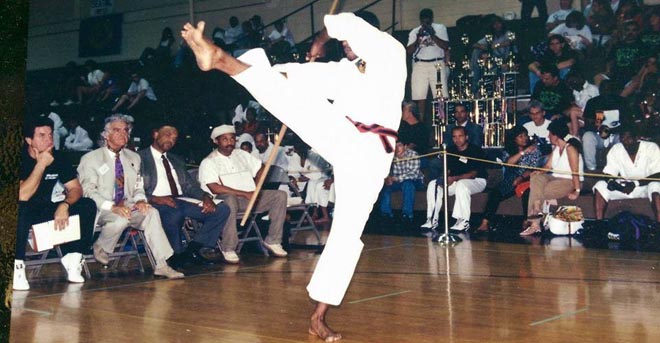

“’Times are a changing.’ We have all heard that quote repeatedly. Kuroshi-Do “The Ever-Changing System” is keeping up with those changes.
Make plans to attend the Kuroshi-do 35th Anniversary, Dinner and Celebration on November 14th, 2009. Martialforce will be there.
Thank you Haisan Kaleak Soke, for the opportunity to interview you and experience Martial Arts at Its Best.”
Special note from Eddie Morales:
I have known Haisan Kaleak for many years and his technique and approach to Defensive Tactics is hardcore, realistic and tactically sound by any standard. His in-depth analytical study of technique coupled with the passion to improve and willingness to impart his knowledge makes for a great instructor and more over great human being.
As he explains the bio-mechanical functions of a technique in relation to the natural flowing movement of the human body, it becomes obvious to anyone present that Martial arts is a science of which Haisan Kaleak has a thorough understanding.
When watching Haisan Kaleak execute techniques you are reminded of a flowing stream of water with the definite crash of rocks as he makes contact.
We here at Martialforce.com, are happy we were fortunate enough to get this interview. I can say definitively that Kuroshido is a driving and powerful force in the Martial Arts world with exceptional Martial Artist as its Founders.
Thank you Haisan Kaleak, Soke for this interview.
To Contact Soke Haisan Kaleak – email Soke318@aol.com
BOOK REVIEW
"I AM KUROSHI-DO"
By Haisan Kaleak
All information in this interview regarding Kuroshi-do have been verified with lusayne Steve Alston and Salim Al Rashid who were both present in its conception and development.
Photographs were removed from this interview a few days after it was presented as a result of a call received regarding ownership. We got permission from one party but were asked if we could remove pictures by a second party. We removed the photographs to be consistent with "E" Section of our disclaimer. The person did not actually prove that the photographs were owned by him but we did it as a courtesy as it did not affect the interview.
